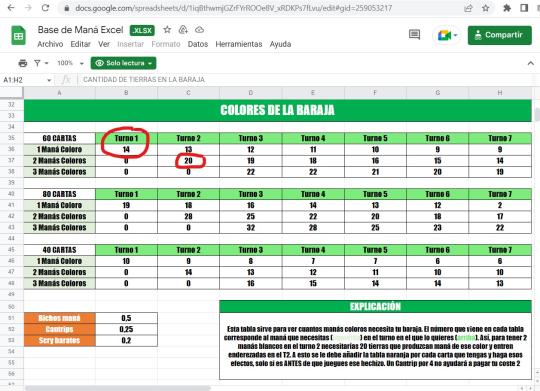A few months ago I saw a Twitter user named Playmobil sharing an Excel that helped us build a solid mana base based on numbers by taking into account various variables like curve and card cost.
Since then I have stopped creating mana bases based on symmetry, trial and error, intuition or beliefs, to make them based on probabilities, on the numbers in this Excel.
Since I didn't want to go to Excel every time I wanted to set up a mana base, I kept a couple of magic numbers, which allowed me to solve most cases. Those numbers are 14 and 20.
…
A few months ago I saw a Twitter user named Playmobil sharing an Excel that helped us build a solid mana base based on numbers by taking into account various variables like curve and card cost.
Since then I have stopped creating mana bases based on symmetry, trial and error, intuition or beliefs, to make them based on probabilities, on the numbers in this Excel.
Since I didn't want to go to Excel every time I wanted to set up a mana base, I kept a couple of magic numbers, which allowed me to solve most cases. Those numbers are 14 and 20.
These numbers are going to give us more than 80% in a deck of 60 cards. For example:
- If we have one cost blue cards and we want to be able to play them with these guarantees, we must put 14 untapped lands that produce blue mana.
- If the blue card that we want to play on turn two is cost two, we will need a card minus 14 -1 = 13 lands. And since it's turn two, they don't need to be untapped lands anymore, because we'll be able to play them tapped on turn one.
- If we want to play a three-cost blue card on the third turn: 14 -2 = 12, these are the blue lands that we must include in our main list.
Therefore the formula would be: 14 -(turn-1).
The same thing happens with 20, but for double-cost cards and from the second turn, of course. For example:
- If we want to play a white creature with double white cost, we must play 20 white lands that produce white and also 13 (14 -1) of these lands must enter untapped to be able to play our double cost white creature with these guarantees.
- If we want to play a double white cost on the third turn, we will need 19 (20 -1) lands that produce white.
- 18 (20 -2) for a double white cost on the fourth turn.
Therefore the formula would be: 20 -(turn-2).
We will make a subsection to explain this "these guarantees". If we work with these numbers it is because they are comfortable for us to build a deck where one out of every five times it will behave as we have foreseen.
We could increase the magic number to have higher odds, but it would no longer be as flexible and workable numbers to address all the variables that, as we will see below, are not only for adjusting the mana base.
As we have anticipated before, these magic numbers also help us adjust the rest of the cards in our deck, not just the mana base. For example:
- If we want to play a cost two with these guarantees, we'll need to set up our deck with 13 (14 -1) untapped lands. And this is a very important requirement to keep in mind so as not to overdo it by including an excess of capped lands.
- If we want to play a cost two creature after playing the Kumano Saga that puts a counter on the next creature we play, how many do we need? 13 (14 -1).
To play this cost one red saga? 14 red lands uncovered.
This rule of three or simple formula has greatly improved my game. I no longer think that I have made a mistake putting in less land than I should have because chance has played a trick on me.
We agree that chance can betray you, but it also preys on our rival indistinctly. Therefore, for me it is a variable that you cannot manage and that tends to 50% between stealing well and poorly. Chance at one of its extremes only serves to test your temperance.
We are interested in the probabilities and that the numbers of the cards that we carry in our deck have a certain logic and guarantees, no conjectures, intuitions, symmetries or beliefs. Magic are numbers and if you take them into account, the odds will be on your side.
Try using these magic numbers 14 and 20 and leave me a comment on how it went. Until next time.
Welcome to MTGsearch.it 3.0
—MTG's first social network- Posts from other players.
- The latest Magic expansions for the Standard and Explorer player.
- The deck archetypes currently being played in MTG Arena, with a list proposed by our Ai.
- The decks uploaded by other players on this platform.
- A store where you can acquire experience points, level up and more things that we will be adding.
- A standard deck builder.
- A list of users of this social network ordered by the most recent date of the last one they published.
- Access to your user profile where you can change your icon, set a page header and background.
- And a settings section where you can change the theme from dark to light and choose the main color of the platform.
- Finally, we invite you to post something that you think might be interesting to share with other users.
This information will only be visible for tiers 0 and 1.

Lobo Blanco
Tier: 9Magic are Numbers

Comment?